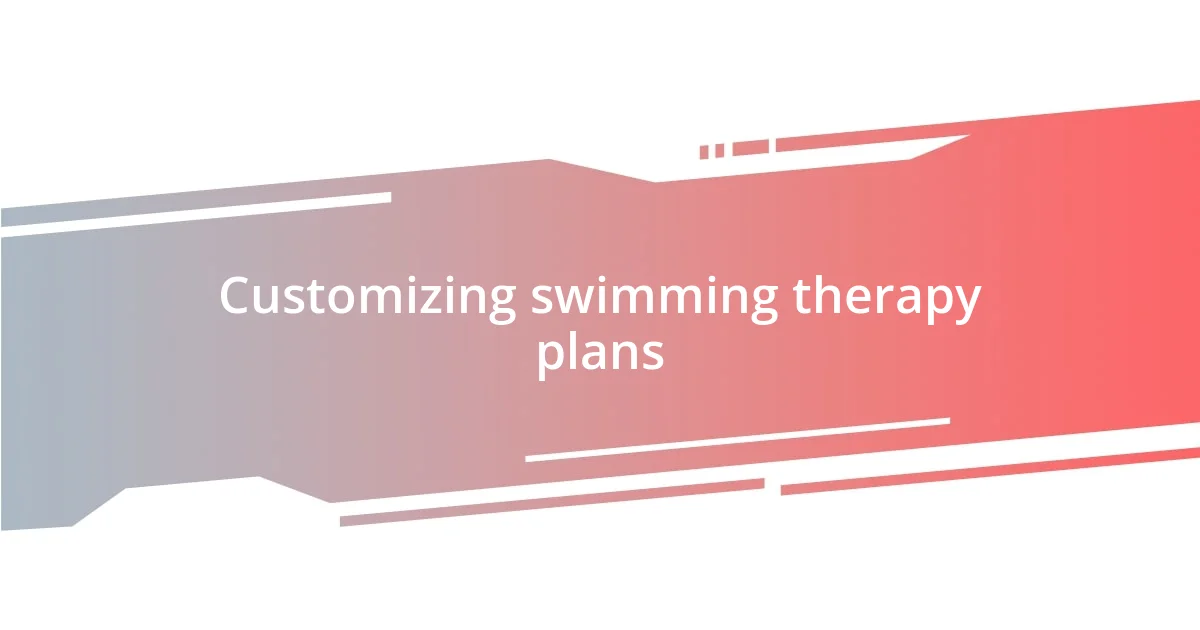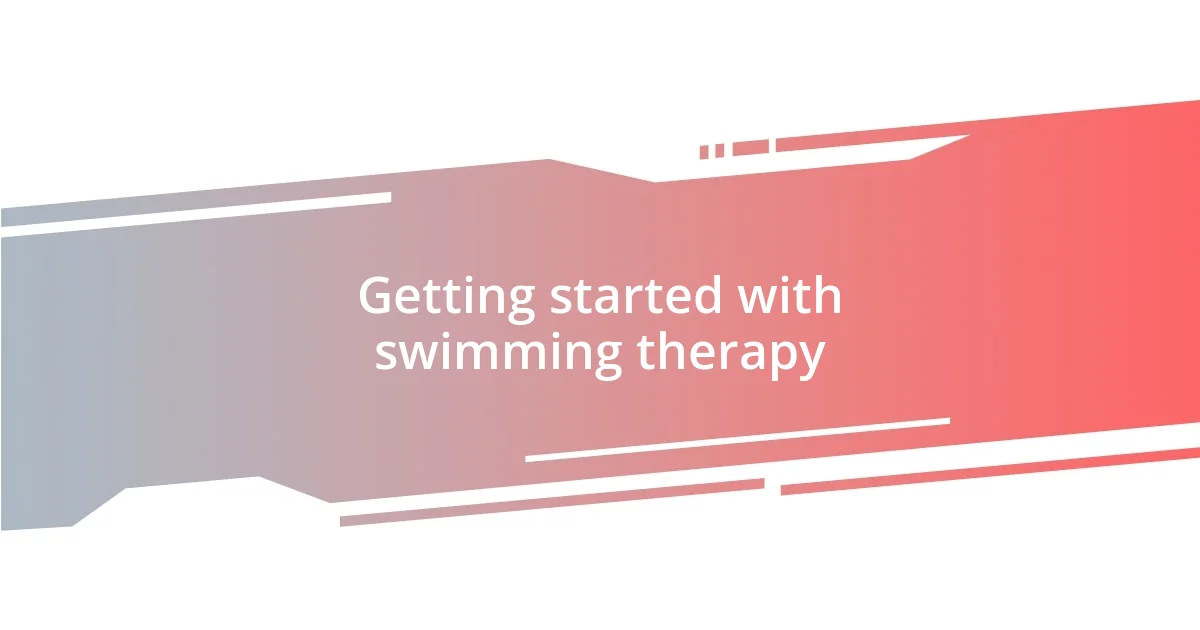Key takeaways:
- Swimming therapy offers not only physical rehabilitation but also emotional support, enhancing mental health and fostering community through group sessions.
- Customizing therapy plans to individual needs, including diverse techniques and gradual progression, significantly aids recovery and motivation.
- Success stories illustrate swimming’s transformative power, as seen in individuals overcoming anxiety, communication barriers, and regaining mobility post-injury.

Understanding swimming therapy benefits
Swimming therapy offers a multitude of benefits that extend beyond traditional rehabilitation. From my experience, immersing oneself in water brings a soothing sense of weightlessness, which allows for greater mobility. Have you ever felt the freedom of moving effortlessly in water? It’s a feeling that can rejuvenate not just the body but also the mind.
Emotionally, swimming therapy can be a game-changer. I recall a time when I was feeling overwhelmed by stress; a few gentle laps in the pool left me uplifted and refreshed. The rhythmic nature of swimming can create a meditative state, fostering a sense of peace that can be difficult to achieve on land. It’s fascinating how water can transform our mental and emotional states, isn’t it?
Finally, let’s not overlook the social aspect of swimming therapy. Participating in group sessions can create a sense of community and support that is invaluable. I’ve witnessed how individuals bond over shared experiences in the water, building friendships that aid in the healing journey. Isn’t it amazing how a simple activity can weave connections that enrich our lives?

Techniques used in swimming therapy
When it comes to swimming therapy, the techniques utilized are remarkably diverse, catering to individual needs and abilities. I’ve seen firsthand how tailored approaches can make a substantial difference. For example, gentle stretches in water can enhance flexibility while providing a comforting support system that you simply don’t find on land. It’s truly invigorating to feel that stretch without the usual strain on your joints.
Here are some key techniques I’ve encountered in swimming therapy:
- Aquatic Exercises: Engaging in activities like treading water or using resistance tools helps build strength and endurance.
- Breath Control: Learning to manage my breathing underwater has transformed my sense of calm and improved my lung capacity.
- Hydrotherapy: Targeted treatments using jets and bubble therapy can alleviate pain and enhance circulation.
- Water Walking: This technique simulates land-based walking but with reduced impact, making it easier for those with mobility issues.
- Group Dynamics: Participating in group exercises fosters camaraderie and boosts motivation, which I’ve found immensely rewarding.
A perfect memory that stands out for me is when I was involved in a group session, watching participants encourage one another in the water. It was heartfelt. The positivity radiated through the pool, demonstrating just how influential these techniques can be, not only for physical recovery but also for emotional healing.

Swimming therapy for rehabilitation
Swimming therapy plays a pivotal role in rehabilitation, often helping individuals regain strength and mobility after injury or surgery. I remember working with someone who had knee surgery; the buoyancy of the water allowed them to move freely without pain. This gentle reintroduction to movement truly highlighted how the aquatic environment can facilitate recovery while minimizing discomfort.
There’s a unique connection that forms when you’re in the water, especially during rehabilitation sessions. During one memorable session, I noticed participants sharing their stories, fostering a supportive atmosphere that enhanced everyone’s confidence. This sense of community not only motivates individuals to push through their challenges but also nurtures emotional resilience, which can significantly speed up the rehabilitation process.
The integration of swimming therapy into rehab regimens also allows for gradual progression. I once guided a friend through alternate swimming strokes as part of their recovery plan, each stroke targeting different muscle groups. We observed remarkable improvements in strength and coordination over time. This experience reinforced my belief that swimming therapy isn’t just about physical rehabilitation; it’s about nurturing the spirit and fostering a positive mindset throughout the healing journey.
| Aspect | Traditional Rehabilitation | Swimming Therapy |
|---|---|---|
| Pain Management | Land-based exercises can cause discomfort. | Buoyancy reduces stress on joints, enabling pain-free movement. |
| Mobility | Progress may be slow due to restrictions. | Water provides support, allowing a greater range of motion. |
| Emotional Support | Often solitary, lacking camaraderie. | Group sessions foster community and encouragement. |
| Skill Development | Physical therapy may lack diversity. | Variety of aquatic techniques target different muscle groups effectively. |

Enhancing mental health through swimming
Swimming has a unique way of enhancing mental health that often goes overlooked. I vividly recall the first time I dove into the pool after a particularly stressful week. As I glided through the water, I felt a wave of tranquility wash over me. Isn’t it fascinating how a simple activity like swimming can quiet the mind and lift the spirit?
One aspect I find particularly compelling is how swimming creates a meditative environment. The rhythmic sound of water splashing, combined with the focus on breath control, can transform your mindset. During my sessions, I noticed that I not only built physical endurance but also emotional resilience. Have you ever experienced that moment when all your worries seem to fade away with each stroke? It’s empowering to realize that I have the ability to quiet my thoughts simply through movement.
Additionally, the social element of swimming therapy cannot be overstated. While I was part of a group session, we shared laughter and encouragement, creating an uplifting atmosphere that fostered connection. It’s incredible how these interactions can elevate our mood and contribute to mental well-being. I often think about how much stronger and more supported we feel when we swim together. Isn’t that a beautiful reminder of the power of community?

Customizing swimming therapy plans
Customizing swimming therapy plans is essential to meet the unique needs of each individual. Early on in my experience, I worked with a woman recovering from a severe back injury who needed a tailored approach. We focused on hydrotherapy exercises that emphasized gentle stretching and strengthening, which not only helped her regain mobility but also boosted her confidence in the water. Doesn’t it make sense that a personalized plan can address specific concerns and limitations?
I’ve found that incorporating a variety of swimming techniques into therapy can keep participants engaged and motivated. For instance, I once introduced aqua jogging to a group that was struggling to stay enthusiastic. The change in routine revitalized their spirits, and I could see the joy come back into their faces as they splashed around in the shallow end. Isn’t it invigorating how a little variation can breathe new life into a program?
Moreover, I believe it’s vital to regularly assess and adjust the swimming therapy plans as individuals progress. I vividly remember someone who started with basic floating exercises but quickly moved on to more complex drills as her strength improved. It was a joy to witness her transformation while also refining her plan to align with her evolving capabilities. How rewarding is it to see that progression and adapt our approach accordingly? This flexibility not only supports physical improvements but also nurtures a sense of achievement and motivation in those undergoing rehabilitation.

Success stories from swimming therapy
Seeing success stories in swimming therapy is nothing short of inspiring. I recall a particular case of a young boy who struggled with autism. When he first entered the pool, he seemed anxious and withdrawn. But as the sessions progressed, I watched him slowly transform. The water became his safe haven, helping him communicate with his therapist through play and movement. Isn’t it amazing how swimming can bridge gaps in communication and foster connection in unexpected ways?
Another success story that stands out is that of an elderly man recovering from a stroke. At first, he was hesitant to even enter the water. Yet, with gentle encouragement and tailored exercises, his confidence grew. Over time, he not only regained mobility in his limbs but also found joy in swimming unexpectedly. Watching his eyes light up with pride after completing a lap brought back memories of my own achievements in the water. Don’t you think these moments remind us of the profound impact swimming can have on rehabilitation?
One particular instance hits home for me; I once guided a group of teenagers battling anxiety. We established a weekly swimming therapy session where they could freely express their frustrations. Over the course of just a few weeks, I saw them move from timid splashes to enthusiastic races across the pool. Their laughter echoed louder each time, and it struck me how the water served as a liberating force for them. Isn’t it heartwarming to see how a shared experience like swimming can create a safe space for vulnerability and growth? Every success story in swimming therapy highlights just how transformative the journey can be.

Getting started with swimming therapy
Getting started with swimming therapy can feel daunting, but I assure you, taking that first plunge is often the most rewarding step. I remember the nervous butterflies I felt the first time I sat by the pool, preparing to guide a young woman overwhelmed by her anxiety about the water. It amazed me how simply introducing her to a gentle floating exercise created a calm, inviting atmosphere where she could begin to explore her fears. Have you ever felt that spark of comfort when trying something new?
To really kick off a swimming therapy program, it’s essential to focus on building trust within the water. I once worked with a middle-aged man who was wary due to a previous near-drowning incident. Initially, we spent time just sitting by the pool, discussing his experiences, all while demonstrating various water readiness activities. It was incredible to witness how those gentle interactions not only eased his fears but allowed him to eventually find joy in the water. Isn’t it amazing how the process of simply engaging with someone can pave the way for transformation?
As you embark on this journey, remember that creating a serene environment is just as crucial as the therapy itself. In my experience, music and soft lighting around the pool can contribute significantly to a therapeutic atmosphere. I frequently play relaxing tunes that foster a sense of peace, leading participants to focus more on themselves rather than their surrounding fears. It’s surprising how small touches like these can enhance motivation and openness to the therapy process. Don’t you think cultivating a nurturing space can make all the difference in one’s healing journey?














